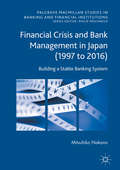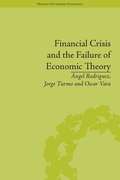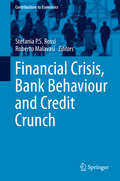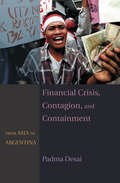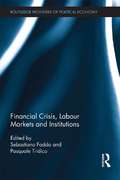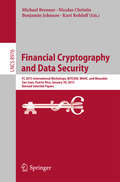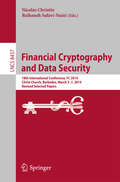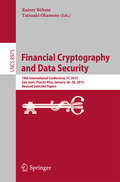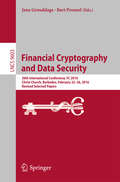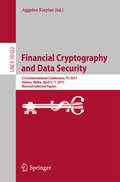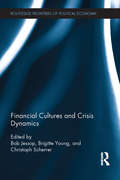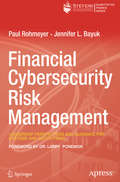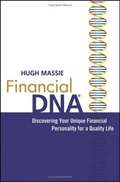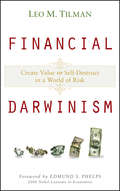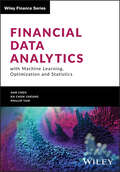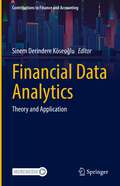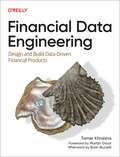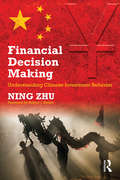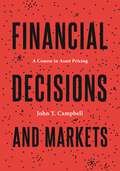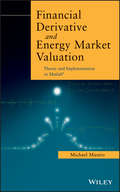- Table View
- List View
Financial Crisis and Bank Management in Japan: Building a Stable Banking System (Palgrave Macmillan Studies in Banking and Financial Institutions)
by Mitsuhiko NakanoThis book explores the challenges faced by the Japanese economy and the Japanese banking industry following the financial crisis that emerged around the turn of the last millennium. The author explores how the Japanese financial crisis of the late 1990s engendered huge restructuring efforts in the banking industry, which eventually led to even more sweeping changes of the economic system and long-term deflation in the 2000s. The discussion begins with an overview of the unconventional monetary policy launched by the Bank of Japan at this time, while banking administrative policies maintained their strict code of governance. The author describes how, just as recovery seemed possible, the twin disasters of the Lehman shock and the Great East Japan Earthquake buffeted the recovering economy, and pushed Japan again into deflation. The book also looks to the very recent past, with the sudden advent of Abenomics in 2013, with its three-pronged approach, which was intended to break the deflationary mindset. Finally, the author projects what the future of the banking industry in Japan might encompass, as looming demographic changes gradually threaten both the economy and the banking industry.
Financial Crisis and Institutional Change in East Asia
by Jikon LaiIn light of the Asian financial crisis of 1997, Lai examines whether East Asian economies converged onto the liberal market model by studying the evolution of the financial sectors of Korea, Malaysia and Thailand. This includes sectoral diversification, the nature of competition, and the regulatory and supervisory frameworks.
Financial Crisis and the Failure of Economic Theory (Modern Heterodox Economics #2)
by Jorge Turmo ArnalFirst Published in 2016. Routledge is an imprint of Taylor & Francis, an Informa company.
Financial Crisis in Asia: 1997-1998 (Abridged)
by Jonathan Schlefer Rafael Di Tella Huw PillWhat caused the 1997-98 Asia Crisis: Asian nations' poor economic management, international financial contagion, close "crony" relations between local politicians and capitalists? This case examines how the crisis erupted in Thailand and spread in a chain of events that no one-neither Asian financial authorities nor Western economists-had foreseen. The crisis raises questions about how competently financial institutions such as mutual funds managed their global capital investments. It raises questions about how effective the International Monetary Fund's package of reforms was-and to what extent the IMF acted in the interest of Wall Street rather than developing nations. And the crisis raises questions about the development policies of Asian nations: Did too-close "crony" relations between politicians and owners of major banks or firms pave the way for crisis?
Financial Crisis, Bank Behaviour and Credit Crunch
by Stefania P.S. Rossi Roberto MalavasiThis book explores some relevant distortions and market failures in financial and banking markets caused by the recent financial crisis and offers important insights to policymakers as well. After having introduced the reader to the economic background behind the origin of the present financial turmoil, the book proposes a distinct angle to look at some macro and microeconomic aspects. The volume discusses whether and to what extent policies, implemented by governments and monetary authorities to countervail bank defaults and avoid a disastrous financial instability, have in some way determined opportunistic conducts (moral hazard), changes in banks' behaviour, distortive incentives and market failures. Furthermore, the book offers a viewpoint on the effects of the evolution of regulation for the banking sector. Finally, the book assesses how the increase in the cost of funding and the shrinking in credit supply (credit crunch) has modified the financial structure of small and medium firms. To illustrate this, some specific cases at Italian regional level are examined.
Financial Crisis, Contagion, and Containment: From Asia to Argentina
by Padma DesaiThis book provides a sweeping, up-to-date, and boldly critical account of the financial crises that rocked East Asia and other parts of the world beginning with the collapse of the Thai baht in 1997. Retracing the story of Asia's "Crisis Five"--Indonesia, Malaysia, South Korea, the Philippines, and Thailand--Padma Desai argues that the region's imprudently fast-paced opening to the free flow of capital was pushed by determined advocates, official and private, in the global economy's U.S.-led developed center. Turmoil ensued in these peripheral economies, the Russian ruble faltered, and Brazil was eventually hit. The inequitable center-periphery relationship also extended to the policy measures that the crisis-swept economies implemented under International Monetary Fund bailouts, which intensified the downturns induced by the panic-driven outflows of short-term capital. Financial Crisis, Contagion, and Containment examines crisis origin and resolution in a comparative perspective by combing empirical evidence from the most robust economies to the least. Why is the U.S. relatively successful at weathering economic ups and downs? Why is Japan stuck in policy paralysis? Why is the European Central Bank unable to achieve both inflation control and stable growth? How can emerging markets avoid turbulence amid free-flowing speculative capital from private lenders of the developed center? Engaging and nontechnical yet deeply insightful, this book appears at a time when the continuing turmoil in Argentina has revived policy debates for avoiding and addressing financial crises in emerging market economies.
Financial Crisis, Corporate Governance, and Bank Capital
by Sanjai BhagatIn the aftermath of the 2007-8 crisis, senior policymakers and the media have blamed excessive risk-taking undertaken by bank executives, in response to their compensation incentives, for the crisis. The inevitable follow-up to this was to introduce stronger financial regulation, in the hope that better and more ethical behaviour can be induced. Despite the honourable intentions of regulation, such as the Dodd-Frank Act of 2010, it is clear that many big banks are still deemed too big to fail. This book argues that by restructuring executive incentive programmes to include only restricted stock and restricted stock options with very long vesting periods, and financing banks with considerably more equity, the potential of future financial crises can be minimized. It will be of great value to corporate executives, corporate board members, institutional investors and economic policymakers, as well as graduate and undergraduate students studying finance, economics and law.
Financial Crisis, Labour Markets and Institutions (Routledge Frontiers of Political Economy #170)
by Pasquale Tridico Sebastiano FaddaThis book seeks to explain the global financial crisis and its wider economic, political, and social repercussions, arguing that the 2007-9 meltdown was in fact a systemic crisis of the capitalist system. The volume makes these points through the exploration of several key questions: What kind of institutional political economy is appropriate to explain crisis periods and failures of crisis-management? Are different varieties of capitalism more or less crisis-prone, and can the global financial crisis can be attributed to one variety more than others? What is the interaction between the labour market and the financialization process? The book argues that each variety of capitalism has its own specific crisis tendencies, and that the uneven global character of the crisis is related to the current forms of integration of the world market. More specifically, the 2007-09 economic crisis is rooted in the uneven income distribution and inequality caused by the current financial-led model of growth. The book explains how the introduction of more flexibility in the labour markets and financial deregulation affected everything from wages to job security to trade union influence. Uneven income distribution and inequality weakened aggregate demand and brought about structural deficiencies in aggregate demand and supply. It is argued that the process of financialization has profoundly changed how capitalist economies operate. The volume posits that financial globalization has given rise to growing international imbalances, which have allowed two growth models to emerge: a debt-led consumption growth model and an export-led growth model. Both should be understood as reactions to the lack of effective demand due to the polarization of income distribution.
Financial Cryptography and Data Security
by Michael Brenner Nicolas Christin Benjamin Johnson Kurt RohloffThis book constitutes the refereed proceedings of three workshops held at the 19th International Conference on Financial Cryptography and Data Security, FC 2015, in San Juan, Puerto Rico, in January 2015. The 22 full papers presented were carefully reviewed and selected from 39 submissions. They feature the outcome of the Second Workshop on Bitcoin Research, BITCOIN 2015, the Third Workshop on Encrypted Computing and Applied Homomorphic Cryptography, WAHC 2015, and the First Workshop on Wearable Security and Privacy, Wearable 2015.
Financial Cryptography and Data Security
by Nicolas Christin Reihaneh Safavi-NainiThis book constitutes the thoroughly refereed post-conference proceedings of the 18th International Conference on Financial Cryptography and Data Security (FC 2014), held in Christ Church, Barbados, in March 2014. The 19 revised full papers and 12 short papers were carefully selected and reviewed from 165 abstract registrations and 138 full papers submissions. The papers are grouped in the following topical sections: payment systems, case studies, cloud and virtualization, elliptic curve cryptography, privacy-preserving systems, authentication and visual encryption, network security, mobile system security, incentives, game theory and risk, and bitcoin anonymity.
Financial Cryptography and Data Security
by Rainer Böhme Tatsuaki OkamotoThis book constitutes the thoroughly refereed post-conference proceedings of the 19th International Conference on Financial Cryptography and Data Security, FC 2014, held in San Juan, Puerto Rico, in January 2015. The 23 revised full papers and 10 short papers were carefully selected and reviewed from 102 full papers submissions. The papers are grouped in the following topical sections: sidechannels; cryptography in the cloud; payment and fraud detection; authentication and access control; cryptographic primitives; mobile security; privacy and incentives; applications and attacks; authenticated data structures.
Financial Cryptography and Data Security: 20th International Conference, FC 2016, Christ Church, Barbados, February 22–26, 2016, Revised Selected Papers (Lecture Notes in Computer Science #9603)
by Jens Grossklags and Bart PreneelThis book constitutes the thoroughly refereed post-conference proceedings of the 20th International Conference on Financial Cryptography and Data Security, FC 2016, held in Christ church, Barbados, in February 2016. The 27 revised full papers and 9 short papers were carefully selected and reviewed from 137 full papers submissions. The papers are grouped in the following topical sections: fraud and deception; payments, auctions, and e-voting; multiparty computation; mobile malware; social interaction and policy; cryptanalysis; surveillance and anonymity; Web security and data privacy; Bitcoin mining; cryptographic protocols; payment use and abuse.
Financial Cryptography and Data Security: 21st International Conference, FC 2017, Sliema, Malta, April 3-7, 2017, Revised Selected Papers (Lecture Notes in Computer Science #10322)
by Aggelos KiayiasThis volume contains the workshopproceedings of the accompanying workshops of the 14th Financial Cryptograpy and Data Security International Conference 2010, held on Tenerife, Canary Islands, Spain, January 25-28, 2010. FinancialCryptographyandData Securityis a majorinternationalforumfor research, advanced development, education, exploration, and debate regarding information assurance, with a speci?c focus on commercial contexts. The c- ference covers all aspects of securing transactions and systems and especially encourages original work focusing on both fundamental and applied real-world deployments on all aspects surrounding commerce security. Three workshops were co-located with FC 2010: the Workshop on Real-Life CryptographicProtocolsandStandardization(RLCPS),theWorkshoponEthics in Computer Security Research (WECSR), and the Workshop on Lightweight Cryptography for Resource-Constrained Devices (WLC). Intimate and colorful by tradition, the high-quality program was not the only attraction of FC. In the past, FC conferences have been held in highly research-synergistic locations such as Tobago, Anguilla, Dominica, Key West, Guadelupe, Bermuda, the Grand Cayman, and Cozumel Mexico. 2010 was the ?rst year that the conference was held on European soil, in the Spanish Canary Islands, in Atlantic waters, a few miles across Morocco. Over 100 researchers from more than 20 countries were in attendance.
Financial Cultures and Crisis Dynamics (Routledge Frontiers of Political Economy)
by Brigitte Young Bob Jessop Christoph ScherrerThe recent financial crisis exposed both a naïve faith in mathematical models to manage risk and a crude culture of greed that embraces risk. This book explores cultures of finance in sites such as corporate governance, hedge funds, central banks, the City of London and Wall Street, and small and medium enterprises. It uses different methods to explore these cultures and their interaction with different financial orders to improve our understanding of financial crisis dynamics. The introduction identifies types of cultural turn in studies of finance. Part I outlines relevant research methods, including comparison of national cultures viewed as independent variables, cultural political economy, and critical discourse and narrative policy analysis. Part II examines different institutional cultures of finance and the cult of entrepreneurship. Part III offers historical, comparative, and contemporary analyses of financial regimes and their significance for crisis dynamics. Part IV explores organizational cultures, modes of calculation, and financial practices and how they shape economic performance and guide crisis management. Part V considers crisis construals and responses in the European Union and China. This book’s great strength is its multi-faceted approach to cultures of finance. Contributors deploy the cultural turn creatively to enhance comparative and historical analysis of financial regimes, institutions, organizations, and practices as well as their roles in crisis generation, construal, and management. Developing different paradigms and methods and elaborating diverse case studies, the authors illustrate not only how and why ‘culture matters’ but also how its significance is shaped by different financial regimes and contexts.
Financial Cybersecurity Risk Management: Leadership Perspectives and Guidance for Systems and Institutions
by Jennifer L. Bayuk Paul RohmeyerUnderstand critical cybersecurity and risk perspectives, insights, and tools for the leaders of complex financial systems and markets. This book offers guidance for decision makers and helps establish a framework for communication between cyber leaders and front-line professionals. Information is provided to help in the analysis of cyber challenges and choosing between risk treatment options.Financial cybersecurity is a complex, systemic risk challenge that includes technological and operational elements. The interconnectedness of financial systems and markets creates dynamic, high-risk environments where organizational security is greatly impacted by the level of security effectiveness of partners, counterparties, and other external organizations. The result is a high-risk environment with a growing need for cooperation between enterprises that are otherwise direct competitors. There is a new normal of continuous attack pressures that produce unprecedented enterprise threats that must be met with an array of countermeasures. Financial Cybersecurity Risk Management explores a range of cybersecurity topics impacting financial enterprises. This includes the threat and vulnerability landscape confronting the financial sector, risk assessment practices and methodologies, and cybersecurity data analytics. Governance perspectives, including executive and board considerations, are analyzed as are the appropriate control measures and executive risk reporting.What You’ll LearnAnalyze the threat and vulnerability landscape confronting the financial sectorImplement effective technology risk assessment practices and methodologiesCraft strategies to treat observed risks in financial systemsImprove the effectiveness of enterprise cybersecurity capabilitiesEvaluate critical aspects of cybersecurity governance, including executive and board oversightIdentify significant cybersecurity operational challengesConsider the impact of the cybersecurity mission across the enterpriseLeverage cybersecurity regulatory and industry standards to help manage financial services risksUse cybersecurity scenarios to measure systemic risks in financial systems environmentsApply key experiences from actual cybersecurity events to develop more robust cybersecurity architecturesWho This Book Is For Decision makers, cyber leaders, and front-line professionals, including: chief risk officers, operational risk officers, chief information security officers, chief security officers, chief information officers, enterprise risk managers, cybersecurity operations directors, technology and cybersecurity risk analysts, cybersecurity architects and engineers, and compliance officers
Financial Cycles
by Dimitris N. ChorafasChorafas argues that to overcome the more narrow limits of the business cycle, we need to go beyond its traditional six to seven year focus and address the longer term.
Financial DNA: Discovering Your Unique Financial Personality for a Quality Life
by Hugh MassieHugh addresses what I believe is the most important aspect of achieving economic freedom: Know Thyself The financial planning community owes a great deal to Hugh for his contributions. ----Elizabeth Jetton, CFP, Strategic Advisor, Mercer Advisors, Inc.
Financial Darwinism
by Leo M. Tilman Edmund PhelpsIn Financial Darwinism, author Leo Tilman lays the groundwork for understanding the new financial order by introducing his evolutionary thesis and then outlines an actionable decision-making framework that enables financial institutions and investors to fully leverage the power of business strategy, corporate finance, investment analysis, and risk management. Financial Darwinism is an invaluable road map to today's financial world and an essential guide to surviving and thriving during these challenging times.
Financial Data Analytics with Machine Learning, Optimization and Statistics (Wiley Finance)
by Phillip Yam Sam Chen Ka Chun CheungAn essential introduction to data analytics and Machine Learning techniques in the business sector In Financial Data Analytics with Machine Learning, Optimization and Statistics, a team consisting of a distinguished applied mathematician and statistician, experienced actuarial professionals and working data analysts delivers an expertly balanced combination of traditional financial statistics, effective machine learning tools, and mathematics. The book focuses on contemporary techniques used for data analytics in the financial sector and the insurance industry with an emphasis on mathematical understanding and statistical principles and connects them with common and practical financial problems. Each chapter is equipped with derivations and proofs—especially of key results—and includes several realistic examples which stem from common financial contexts. The computer algorithms in the book are implemented using Python and R, two of the most widely used programming languages for applied science and in academia and industry, so that readers can implement the relevant models and use the programs themselves. The book begins with a brief introduction to basic sampling theory and the fundamentals of simulation techniques, followed by a comparison between R and Python. It then discusses statistical diagnosis for financial security data and introduces some common tools in financial forensics such as Benford's Law, Zipf's Law, and anomaly detection. The statistical estimation and Expectation-Maximization (EM) & Majorization-Minimization (MM) algorithms are also covered. The book next focuses on univariate and multivariate dynamic volatility and correlation forecasting, and emphasis is placed on the celebrated Kelly's formula, followed by a brief introduction to quantitative risk management and dependence modelling for extremal events. A practical topic on numerical finance for traditional option pricing and Greek computations immediately follows as well as other important topics in financial data-driven aspects, such as Principal Component Analysis (PCA) and recommender systems with their applications, as well as advanced regression learners such as kernel regression and logistic regression, with discussions on model assessment methods such as simple Receiver Operating Characteristic (ROC) curves and Area Under Curve (AUC) for typical classification problems. The book then moves on to other commonly used machine learning tools like linear classifiers such as perceptrons and their generalization, the multilayered counterpart (MLP), Support Vector Machines (SVM), as well as Classification and Regression Trees (CART) and Random Forests. Subsequent chapters focus on linear Bayesian learning, including well-received credibility theory in actuarial science and functional kernel regression, and non-linear Bayesian learning, such as the Naïve Bayes classifier and the Comonotone-Independence Bayesian Classifier (CIBer) recently independently developed by the authors and used successfully in InsurTech. After an in-depth discussion on cluster analyses such as K-means clustering and its inversion, the K-nearest neighbor (KNN) method, the book concludes by introducing some useful deep neural networks for FinTech, like the potential use of the Long-Short Term Memory model (LSTM) for stock price prediction. This book can help readers become well-equipped with the following skills: To evaluate financial and insurance data quality, and use the distilled knowledge obtained from the data after applying data analytic tools to make timely financial decisions To apply effective data dimension reduction tools to enhance supervised learning To describe and select suitable data analytic tools as introduced above for a given dataset depending upon classification or regression prediction purpose The book covers the competencies tested by several professional examinations, such as the Predictive Analytics Exam offered by the Society of Actuaries, and the Institute and Faculty of Actu
Financial Data Analytics: Theory and Application (Contributions to Finance and Accounting)
by Sinem Derindere KöseoğluThis book presents both theory of financial data analytics, as well as comprehensive insights into the application of financial data analytics techniques in real financial world situations. It offers solutions on how to logically analyze the enormous amount of structured and unstructured data generated every moment in the finance sector. This data can be used by companies, organizations, and investors to create strategies, as the finance sector rapidly moves towards data-driven optimization.This book provides an efficient resource, addressing all applications of data analytics in the finance sector. International experts from around the globe cover the most important subjects in finance, including data processing, knowledge management, machine learning models, data modeling, visualization, optimization for financial problems, financial econometrics, financial time series analysis, project management, and decision making. The authors provide empirical evidence as examples of specific topics. By combining both applications and theory, the book offers a holistic approach. Therefore, it is a must-read for researchers and scholars of financial economics and finance, as well as practitioners interested in a better understanding of financial data analytics.
Financial Data Engineering: Design and Build Data-Driven Financial Products
by Tamer KhraishaToday, investment in financial technology and digital transformation is reshaping the financial landscape and generating many opportunities. Too often, however, engineers and professionals in financial institutions lack a practical and comprehensive understanding of the concepts, problems, techniques, and technologies necessary to build a modern, reliable, and scalable financial data infrastructure. This is where financial data engineering is needed.A data engineer developing a data infrastructure for a financial product possesses not only technical data engineering skills but also a solid understanding of financial domain-specific challenges, methodologies, data ecosystems, providers, formats, technological constraints, identifiers, entities, standards, regulatory requirements, and governance.This book offers a comprehensive, practical, domain-driven approach to financial data engineering, featuring real-world use cases, industry practices, and hands-on projects.You'll learn:The data engineering landscape in the financial sectorSpecific problems encountered in financial data engineeringThe structure, players, and particularities of the financial data domainApproaches to designing financial data identification and entity systemsFinancial data governance frameworks, concepts, and best practicesThe financial data engineering lifecycle from ingestion to productionThe varieties and main characteristics of financial data workflowsHow to build financial data pipelines using open source tools and APIsTamer Khraisha, PhD, is a senior data engineer and scientific author with more than a decade of experience in the financial sector.
Financial Decision Making: Understanding Chinese Investment Behavior
by Ning ZhuThis book sheds light on financial decision making and lays down the major biases in human behavioral decision making, such as over-confidence, naive extrapolation, attention, and risk aversion, and how they lead investors and corporations to make considerable mistakes in investment. It draws on a large body of literature, from psychology and social psychology to, most importantly, behavioral economics and behavioral finance. It also looks at the progress in behavioral finance research over recent decades and includes research outputs based on retail and institutional investors from the United States, China, and many other international financial markets. The book focuses on China’s financial reforms and economic transition and includes many cases from that country to highlight the importance of behavioral finance and investor education. It therefore provides much needed in-depth understanding of the Chinese capital market.
Financial Decisions and Markets: A Course in Asset Pricing
by John Y. CampbellFrom the field's leading authority, the most authoritative and comprehensive advanced-level textbook on asset pricingIn Financial Decisions and Markets, John Campbell, one of the field&’s most respected authorities, provides a broad graduate-level overview of asset pricing. He introduces students to leading theories of portfolio choice, their implications for asset prices, and empirical patterns of risk and return in financial markets. Campbell emphasizes the interplay of theory and evidence, as theorists respond to empirical puzzles by developing models with new testable implications. The book shows how models make predictions not only about asset prices but also about investors&’ financial positions, and how they often draw on insights from behavioral economics.After a careful introduction to single-period models, Campbell develops multiperiod models with time-varying discount rates, reviews the leading approaches to consumption-based asset pricing, and integrates the study of equities and fixed-income securities. He discusses models with heterogeneous agents who use financial markets to share their risks, but also may speculate against one another on the basis of different beliefs or private information. Campbell takes a broad view of the field, linking asset pricing to related areas, including financial econometrics, household finance, and macroeconomics. The textbook works in discrete time throughout, and does not require stochastic calculus. Problems are provided at the end of each chapter to challenge students to develop their understanding of the main issues in financial economics.The most comprehensive and balanced textbook on asset pricing available, Financial Decisions and Markets is an essential resource for all graduate students and practitioners in finance and related fields.Integrated treatment of asset pricing theory and empirical evidenceEmphasis on investors&’ decisionsBroad view linking the field to financial econometrics, household finance, and macroeconomicsTopics treated in discrete time, with no requirement for stochastic calculusSolutions manual for problems available to professors
Financial Deepening in the CFA Franc Zone: The Role of Institutions
by Kangni Kpodar Dhaneshwar Ghura Raju Jan SinghA report from the International Monetary Fund.
Financial Derivative and Energy Market Valuation
by Michael MastroA road map for implementing quantitative financial modelsFinancial Derivative and Energy Market Valuation brings the application of financial models to a higher level by helping readers capture the true behavior of energy markets and related financial derivatives. The book provides readers with a range of statistical and quantitative techniques and demonstrates how to implement the presented concepts and methods in Matlab®.Featuring an unparalleled level of detail, this unique work provides the underlying theory and various advanced topics without requiring a prior high-level understanding of mathematics or finance. In addition to a self-contained treatment of applied topics such as modern Fourier-based analysis and affine transforms, Financial Derivative and Energy Market Valuation also:* Provides the derivation, numerical implementation, and documentation of the corresponding Matlab for each topic* Extends seminal works developed over the last four decades to derive and utilize present-day financial models* Shows how to use applied methods such as fast Fourier transforms to generate statistical distributions for option pricing* Includes all Matlab code for readers wishing to replicate the figures found throughout the bookThorough, practical, and easy to use, Financial Derivative and Energy Market Valuation is a first-rate guide for readers who want to learn how to use advanced numerical methods to implement and apply state-of-the-art financial models. The book is also ideal for graduate-level courses in quantitative finance, mathematical finance, and financial engineering.
